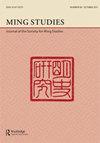Signaling Seduction: The Courtship Strategies of Ming Era Courtesans
IF 0.3
0 ASIAN STUDIES
引用次数: 0
Abstract
This study applies an interdisciplinary approach to the study of Ming period courtesans (ji 妓) and their activities, combining the close reading of literature and Ming era visual presentations, with insights drawn from the fields of modern courtship and nonverbal behavioral studies to investigate their strategies of signaling seduction. In the Ming era, courtesans used a series of seduction strategies to achieve their goals in the process of interacting with male clients, dividing the entire courtship process into four phases: attention catching, interacting, and developing intimacy, lovemaking, and post-passion transition back to mundane interaction. This study pays close attention to the first two phases. The strategies of the first stage include posture readiness, prop handling, gestural movements, and vocal manipulation. The strategies of the second stage include conversations and touching. Developing high-level skills in signaling seduction was crucial to success in the career of a Ming courtesan. The specific strategies and the order in which they occurred did not appear to be fixed, but courtesans had to be sensitive and adaptable depending to the personalities and needs of their guests.信号诱惑:明代交际花的求爱策略
本研究采用跨学科的研究方法,结合文献细读和明代视觉呈现,结合现代求偶和非语言行为研究领域的见解,研究明代交际花(ji妓)及其活动的信号诱惑策略。明代的交际花在与男客交往的过程中,为了达到自己的目的,使用了一系列的引诱策略,将整个求偶过程分为四个阶段:吸引注意力、互动并发展亲密关系、做爱、激情后过渡到世俗交往。本研究主要关注前两个阶段。第一阶段的策略包括姿势准备、道具处理、手势动作和声音操纵。第二阶段的策略包括对话和触摸。培养高层次的引诱技巧是明朝交际花事业成功的关键。具体的策略和发生的顺序似乎并不是固定的,但交际花必须敏感和适应取决于客人的个性和需求。
本文章由计算机程序翻译,如有差异,请以英文原文为准。
求助全文
约1分钟内获得全文
求助全文

 求助内容:
求助内容: 应助结果提醒方式:
应助结果提醒方式:


